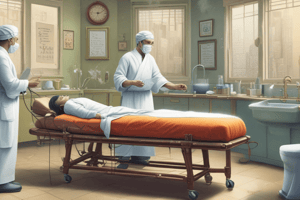Podcast
Questions and Answers
What should be done immediately after blood exposure?
What should be done immediately after blood exposure?
- Report the incident to a regulatory body.
- Apply perfume to mask the smell.
- Wash the area with soap and water. (correct)
- Wait for symptoms to appear.
Which of the following is essential for workstation hygiene?
Which of the following is essential for workstation hygiene?
- Cleaning and sanitizing surfaces regularly. (correct)
- Disinfecting tools before each client.
- Wearing gloves while working on surfaces.
- Using disposable items only.
What is the purpose of personal protective equipment (PPE) when handling blood?
What is the purpose of personal protective equipment (PPE) when handling blood?
- To comply with optional safety measures.
- To protect the worker from potential infection. (correct)
- To minimize the amount of waste generated.
- To improve the aesthetic appearance of the worker.
What type of disposal method should be used for contaminated materials?
What type of disposal method should be used for contaminated materials?
Which aspect of infection prevention techniques involves client interaction?
Which aspect of infection prevention techniques involves client interaction?
What does OSHA stand for, in the context of bloodborne pathogen standards?
What does OSHA stand for, in the context of bloodborne pathogen standards?
What should be done with cleaning agents to ensure safety?
What should be done with cleaning agents to ensure safety?
What is a requirement for hair care professionals regarding licensing?
What is a requirement for hair care professionals regarding licensing?
Flashcards are hidden until you start studying
Study Notes
Blood Exposure Protocols
-
Immediate Response:
- Wash the area with soap and water.
- Apply antiseptic if available.
- Report the incident to the supervisor.
-
Documentation:
- Record the incident details (time, nature of exposure).
- Document any first aid administered.
-
Medical Follow-Up:
- Seek medical evaluation, especially if exposure is from an unknown source.
- Follow any recommended vaccination procedures.
Sanitation Practices
-
Tools and Equipment:
- Disinfect tools (scissors, combs) after each client.
- Use disposable items (razors, gloves) when possible.
-
Workstation Hygiene:
- Clean and sanitize countertops and surfaces regularly.
- Use barriers (e.g., capes) to protect surfaces from contamination.
-
Personal Hygiene:
- Wash hands before and after each client.
- Use hand sanitizer when soap and water are unavailable.
Infection Prevention Techniques
-
Personal Protective Equipment (PPE):
- Wear gloves when handling blood or body fluids.
- Use face shields or masks if splashes are possible.
-
Client Screening:
- Inquire about any infectious conditions prior to services.
- Avoid services if a client has visible blood or open wounds.
-
Education:
- Train staff on infection control measures and protocols.
- Stay updated on best practices for preventing transmission of infections.
Hazardous Materials Handling
-
Blood and Body Fluid Disposal:
- Use biohazard bags for disposal of contaminated materials.
- Follow local regulations for disposing of hazardous waste.
-
Chemical Safety:
- Store cleaning agents properly and label all containers.
- Use Material Safety Data Sheets (MSDS) for guidance on hazardous substances.
Regulatory Compliance Standards
-
OSHA Guidelines:
- Follow Occupational Safety and Health Administration (OSHA) standards for bloodborne pathogens.
- Maintain a written exposure control plan.
-
State Regulations:
- Comply with state health department regulations regarding sanitation and infection control.
-
Licensing Requirements:
- Ensure all hair care professionals are properly licensed and trained in infection control practices.
Blood Exposure Protocols
- Immediate washing of the exposed area with soap and water is crucial to minimize infection risk.
- Applying antiseptic can further disinfect the area if available.
- Reporting the incident to a supervisor is necessary for proper handling and records.
- Documentation of the incident includes time, nature of exposure, and any first aid administered.
- Seek medical evaluation if the source of exposure is unknown, following recommended vaccination procedures.
Sanitation Practices
- Disinfect tools like scissors and combs after each client's use to prevent cross-contamination.
- Use disposable items, such as razors and gloves, to ensure hygienic practices.
- Regular cleaning and sanitizing of countertops and surfaces is essential for workstation hygiene.
- Protect surfaces from contamination with barriers like capes during services.
- Washing hands before and after each client, and using hand sanitizer when necessary, helps maintain personal hygiene.
Infection Prevention Techniques
- Personal protective equipment (PPE), including gloves, is mandatory when handling blood or bodily fluids.
- Face shields or masks should be used to protect against potential splashes.
- Client screening for infectious conditions is important to prevent service to individuals with visible blood or open wounds.
- Staff should be trained on infection control measures, and staying updated on infection prevention best practices is vital.
Hazardous Materials Handling
- Contaminated materials must be disposed of in biohazard bags, following local hazardous waste regulations.
- Cleaning agents should be properly stored and labeled to ensure safety.
- Utilizing Material Safety Data Sheets (MSDS) provides guidance on the safe handling of hazardous substances.
Regulatory Compliance Standards
- Compliance with Occupational Safety and Health Administration (OSHA) guidelines regarding bloodborne pathogens is essential.
- A written exposure control plan must be maintained to outline procedures for handling blood exposure incidents.
- Adherence to state health department regulations on sanitation and infection control is required.
- Ensuring that hair care professionals are properly licensed and trained in infection control practices is pivotal for compliance.
Studying That Suits You
Use AI to generate personalized quizzes and flashcards to suit your learning preferences.



